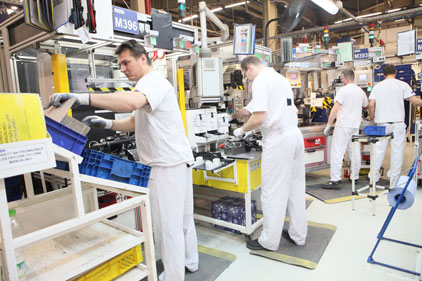Are Cellular Layouts Always Best?

“It may also allow workers and observers to see the flow and to get their arms around the process from start to finish,” says Kurt Greissinger, industry manager for assembly and handling at Bosch Rexroth Corp. “If cells are placed back-to-back with an aisle between them, it allows for efficient material delivery and replenishment for the milk runner.
“Another benefit is that the line can also be staffed according to customer demand; more people during high demand, fewer with less demand,” explains Greissinger. “When designed as U-shaped cells, waste of motion can also be minimized, because the end of the line is adjacent to the beginning of the line.”
Cellular layouts also provide the greatest flexibility with regard to job assignments. “For example, it may be desirable to have the same [assembler] perform the first operation and the last operation, since that combination of process times balances out with the other [assemblers] in the cell and ultimately the demand rate or takt time,” notes Drew Locher, managing director of Change Management Associates.
“This is possible in a layout that closes on itself,” adds Locher. “It would be impractical to do in a straight line configuration. The [assembler] would be running back and forth too much. In some cases, the cellular layout is so tight that a single [assembler] can perform all required operations while maintaining the ideal one-piece flow with minimum motion waste.”
There are many benefits of cellular layouts—if they are correctly designed and implemented by engineers. “They increase material velocity through the plant, improving service levels and improving cash flow; they reduce inventory and the myriad costs associated with it; and they achieve both manufacturing flexibility and team accountability for product and process performance—the holy grails of world-class manufacturing,” claims Don Penkala, president of Granite Bay Global. “But, plant managers tell us the biggest benefit is manufacturing cost reduction and increased plant competitiveness, as a result of the combination of all of these benefits.”
Cellular layouts allow all operators working within the U-shaped area to promote the single-team, single-process concept. Assemblers can communicate more directly with each other and can more readily lend assistance when needed.
“In general, cellular layouts require less space,” says Locher. “This is due in part to the close proximity of the various operations as parts are passed directly from one operation to another. Gone will be space-consuming material handling containers, conveyor systems and the like. With the balance of process times and operations, work-in-process will be drastically reduced, as well as the space required to store it.”
However, it’s not always possible to achieve a U-shaped cell configuration. The size and configuration of the product, materials and equipment may not allow for it. In such cases, other configurations that still promote continuous flow concepts should be considered.
“Cellular certainly isn’t for everybody,” says David Verrill, applications support manager at IAC Industries Inc. “But, to those manufacturers that can use such a layout, it has often been incredibly beneficial.”
Looking for a reprint of this article?
From high-res PDFs to custom plaques, order your copy today!






